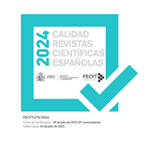Measuring reformulation through eye-tracking. The role of reformulation markers in establishing reformulation: an experimental approach
Resumen
El presente artículo analiza la categoría reformulación como diferenciable de otras categorías próximas, como paráfrasis, conclusión o corrección (Pons Bordería, 2013, 2017). Concretamente, se centra en la relación entre reformulación y marcadores de reformulación en español peninsular. En línea con trabajos previos (Rossari, 1990, 1994), es habitual defender que la paráfrasis puede producirse y asimilarse sin marcadores discursivos dada su base semántico-pragmática de equivalencia, mientras que la reformulación implica un cierto grado de distancia que solo puede ser destacado (o incluso establecido) mediante el uso de marcadores discursivos (por ejemplo, o sea o es decir en español). Los resultados experimentales con eye-tracker (Rayner, 1998, 2009) muestran que la reformulación puede producirse con y sin marcador discursivo; su presencia facilita la asimilación de toda la lectura, pero su ausencia no afecta al procesamiento total del enunciado. Los experimentos con eye-tracker están basados en la hipótesis ojo-mente (Just & Carpenter, 1980), por la que los movimientos oculares al observar un determinado input reflejan su procesamiento cognitivo en términos de mayor o menor dificultad. Este tipo de dato permite complementar ideas teóricas e hipótesis desde una nueva dimensión basada en resultados cualitativos y cuantitativos (Noveck & Sperber, 2004).
Descargas
Descarga artículo
Licencia
La revista Círculo de Lingüística Aplicada a la Comunicación, para fomentar el intercambio global del conocimiento, facilita el acceso sin restricciones a sus contenidos desde el momento de su publicación en la presente edición electrónica, y por eso es una revista de acceso abierto. Los originales publicados en esta revista son propiedad de la Universidad Complutense de Madrid y es obligatorio citar su procedencia en cualquier reproducción total o parcial. Todos los contenidos se distribuyen bajo una licencia de uso y distribución Creative Commons Reconocimiento 4.0 (CC BY 4.0). Esta circunstancia ha de hacerse constar expresamente de esta forma cuando sea necesario. Puede consultar la versión informativa y el texto legal de la licencia.











